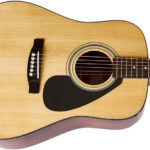It’s a familiar scenario for music lovers: you stumble upon a meme, and suddenly, an infectious electric guitar rock song snippet grabs your attention. You’re hooked, but the track remains unidentified. Frustration mounts as standard song identification methods fail – Googling vague lyrics yields nothing, and even apps like Shazam or Soundhound draw a blank. You’re left wondering, “What is that Electric Guitar Rock Song At The End Of Memes?”
Don’t despair. For years, online communities like Wat Zat Song?, Midomi, and Reddit’s r/NameThatSong have thrived on the collective effort to solve these musical puzzles. And while crowdsourcing is valuable, sometimes you can crack the case yourself with a bit of musical detective work.
Surprisingly, you don’t need to be a musical genius to succeed. Many times, even with songs and artists you’ve never encountered before, the recording itself contains hidden clues waiting to be unlocked. By applying logical deduction and leveraging freely available online resources, you can often identify these elusive tracks.
This guide will walk you through a proven method to identify mystery songs, even those electric guitar rock anthems lurking at the end of your favorite memes, when crowdsourcing isn’t enough. Let’s dive in and equip you with the tools to become your own song-sleuthing expert.
Consider this real-world example shared by Slicing Up Eyeballs on social media platforms like Facebook and Twitter:
Can you ID this funky post-punk song taped off WNYU in the ’80s?
A Slicing Up Eyeballs reader sent us the following note:
“I write from Germany so sorry if i put words wrong. A Friend of mine was in America in the 80s and he listened to WNYU – FM. He heard a Song there but did not hear the Name and Artist. So i have the Link here where you can listen to. If you don`t know it, maybe you can help us with the Lyrics. We went them up and down with no Result. Especially after the beginning words “Oh well oh welcome ….. This might be the Refrain of the Song because he repeats it often in this Song. I would be very glad to get an answer from you because this Song is searched for more than 33 Years.”
The post included a Soundcloud link to the song’s audio and noted it was already an unsolved case on Wat Zat Song? for over five months. Let’s break down the identification process step-by-step.
1. Mining Audio and Lyrics for Keywords: Your Discogs Deep Dive
Discogs stands as a powerhouse for music discovery. It’s a vast community-built database meticulously cataloging artists’ discographies. Beyond its marketplace and collection management features, Discogs boasts a robust search engine. The Advanced Search, accessible without registration, is your secret weapon, allowing precise searches within Track (song) Titles.
 Discogs Advanced Search
Discogs Advanced Search
Alt text: Discogs Advanced Search interface showcasing track title search field, essential for identifying electric guitar rock songs and other genres.
In cases where a song lacks a traditional chorus (common in certain rock subgenres or meme music snippets), focus on deciphering lyrics from the song’s opening. In our example, the initial lyrics were:
Oh well, oh welcome [turncoat?] Sam
He said he was a killer man
He doesn’t care about your [love / life]
The lyrics hint at agit-prop themes, and the repeated opening line offers a potential title fragment. A Discogs Track Title search for “oh well oh welcome” yielded 44 results, a mix of songs containing those keywords in their titles – not necessarily in that exact sequence or song.
2. Refining Your Search: Decade, Region, and Genre Filters
Initial search results can be broad. To narrow down the possibilities, utilize Discogs’ filters. The original poster mentioned the recording was from the ’80s, a decade synonymous with iconic electric guitar rock and post-punk sounds. This timeframe becomes a crucial filter.
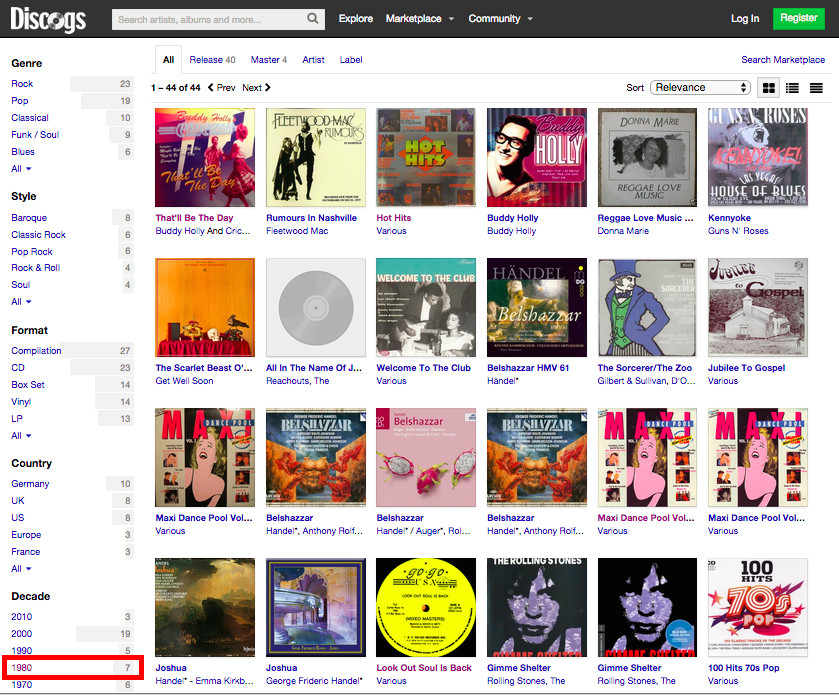 Discogs Search Results
Discogs Search Results
Alt text: Discogs search results page displaying initial broad results for “oh well oh welcome” keyword search, before applying decade filter.
Selecting “Decade > 1980” in the search window’s left-hand menu dramatically reduced the results from 44 to just 7.
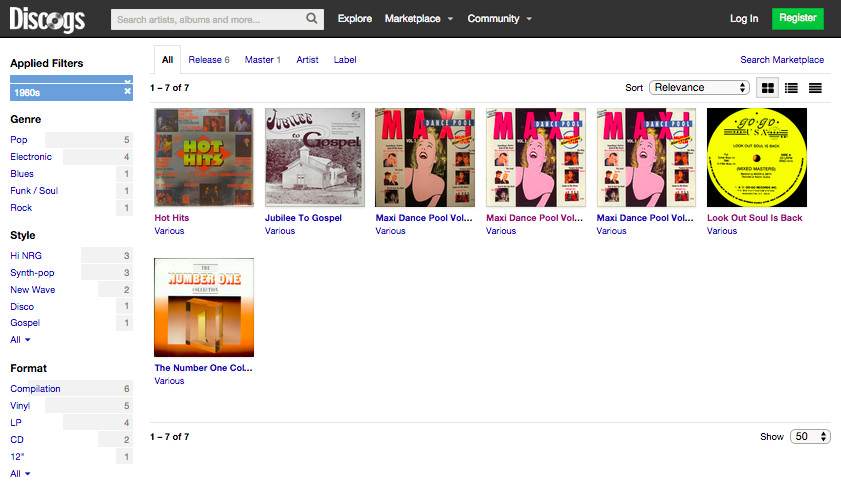 Discogs Filtered Results
Discogs Filtered Results
Alt text: Filtered Discogs search results after selecting the 1980s decade, significantly narrowing down possibilities for the mystery electric guitar rock song.
Genre filtering can be trickier. While Discogs categorizes music, genre classifications (punk, funk, rock, new wave, etc.) can be subjective. For this step, it’s often more effective to visually scan the filtered results and eliminate entries that clearly fall outside the target genre. In this case, gospel, soul, or “Hot Hits” compilations were quickly disregarded. This process left a single promising result: Maxi Dance Pool Vol. 2 – Musikladen Eurotops.
It’s worth noting that Discogs, due to its database structure, might present multiple entries for the same album (master page, different formats like CD and LP). For identification purposes, these are often interchangeable.
3. Streaming Services: Following the Musical Breadcrumbs
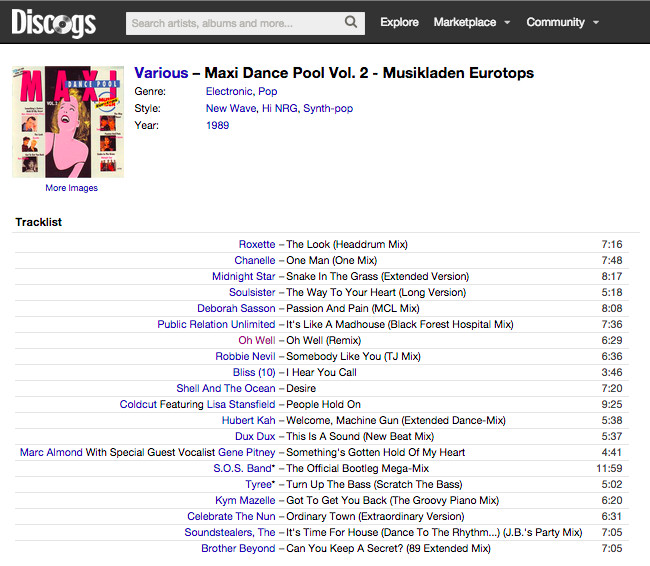 Discogs Master Release Page
Discogs Master Release Page
Alt text: Discogs master release page for “Maxi Dance Pool Vol. 2 – Musikladen Eurotops,” showing track listings and potential clues for identifying electric guitar rock songs.
Despite the title Maxi Dance Pool seeming unlikely for a post-punk track, the keywords “Oh Well” and “Welcome, Machine Gun” within the compilation’s tracklist warranted investigation. “Oh Well” aligned more closely with the deciphered lyrics. Clicking on the hyperlink led to the artist “Oh Well’s” Discogs page, and specifically, the song “Oh Well” with its own subpage and an embedded YouTube video. A quick listen confirmed it wasn’t the target song.
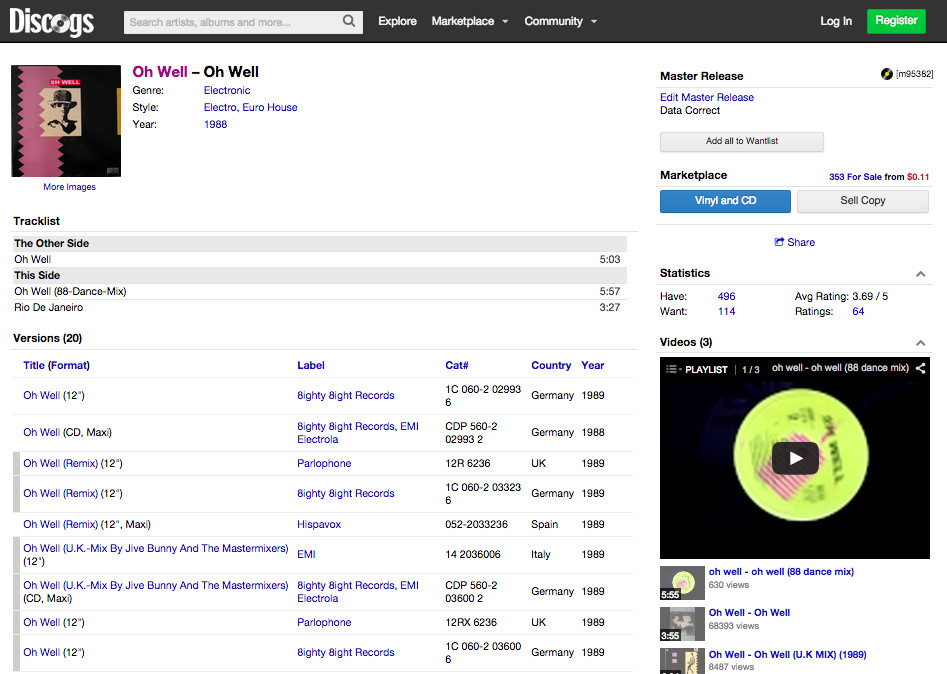 Discogs Single Release Page
Discogs Single Release Page
Alt text: Discogs single release page for “Oh Well – Oh Well,” featuring embedded YouTube video for quick verification if it’s the sought-after electric guitar rock song.
“Machine gun” lyrics were absent from the mystery song, making that track a less probable lead. Time to circle back and refine the search strategy.
4. Iterate and Refine: Persistence Pays Off
The phrase “oh well” on its own felt too generic to be a distinctive song title. Shifting focus, “turncoat Sam” emerged as a more unique and memorable phrase, potentially serving as the song’s hook. However, searches for “turncoat Sam,” “turncoat,” and “welcome turncoat” yielded few relevant results.
Pivoting again, a broader search for “Sam” was conducted, filtered to the 1980s. This still resulted in nearly 2700 releases. Scanning the initial pages, recognizable titles (like T. Rex’s “Telegram Sam”), foreign language entries, and irrelevant genres were quickly eliminated.
Towards the bottom of the result page, a dark, visually striking record cover caught the eye. It hinted at an artier, potentially post-punk or new wave aesthetic, aligning with the perceived vibe of the mystery song.
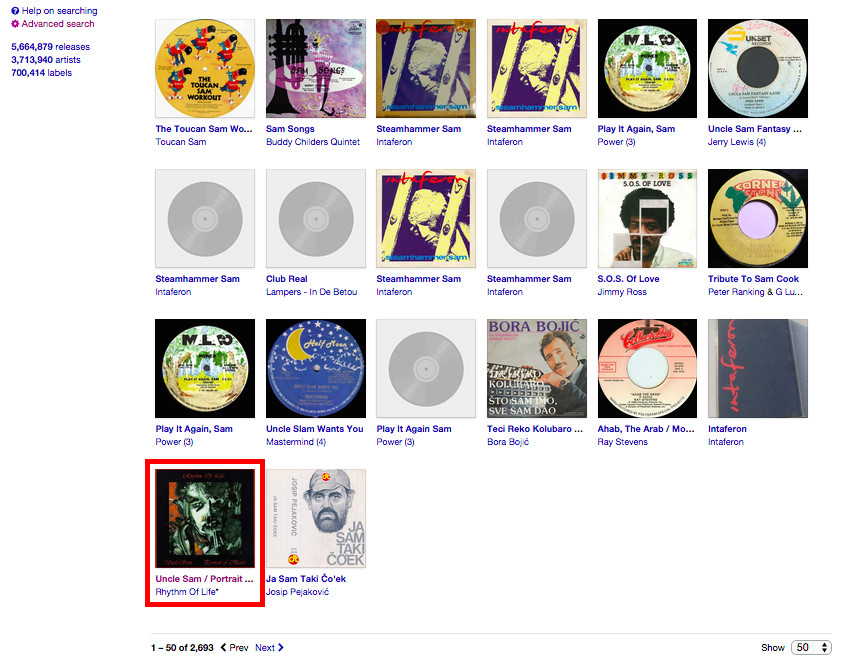 Discogs Sam Search
Discogs Sam Search
Alt text: Discogs search results for “Sam” filtered to the 1980s, highlighting a visually distinctive record cover that led to the discovery of the electric guitar rock song.
The cover belonged to a single titled “Uncle Sam” by Rhythm of Life, an unfamiliar band. Clicking through revealed a UK release from 1981, categorized as New Wave. Discogs’ “similar artists” suggestions (Josef K, Cabaret Voltaire) further strengthened the genre alignment.
A YouTube search for “Rhythm of Life Uncle Sam” produced a single result. After a brief drum intro absent in the original snippet, the mystery song was finally identified. The lyrics weren’t “turncoat Sam” but “Oh well, oh welcome to Uncle Sam,” the words “to” and “Uncle” elided together.
[Editor’s note: The availability of Rhythm of Life’s “Uncle Sam” on YouTube can fluctuate due to copyright. It may not be accessible on major streaming platforms in the US and is found on a 2-CD Paul Haig compilation from Les Disques du Crépuscule label. This highlights the value of personal music libraries as more reliable than streaming services.]
Intuition and luck played a role, but the systematic approach significantly narrowed down the possibilities. Even if the song had been on page 50 of the “Sam” results, the filtering and focused scanning strategy would have increased the chances of discovery. Factors like lyrical content in English, genre familiarity, and era knowledge also contributed to the successful identification. This method has proven effective in solving numerous long-standing mystery song cases.
More Musical Mysteries Solved: Applying the Method
Here are further examples demonstrating the method’s versatility in identifying different genres, including songs that might share qualities with electric guitar rock.
Example #2
Audio clues: A song recorded from a US alternative radio station in 1988. American-sounding artist, roots-rock influences with polished production, reminiscent of the Paisley Underground scene.
Lyrical clues: Jerry Falwell mention confirmed American origin. Chorus-like repetition of:
Whatever name you go by, she goes by now too
What else would she do?
She’s got her last resorts in the mail
To box three five comma oh oh oh
The search: The unusual spoken number “35,000” (thirty-five thousand) became the key. Initially misheard as vocal punctuations, its catchiness and uniqueness made it a prime search term. Given the radio context, a release year around 1987-88 was assumed. Discogs search with “35,000” in Track Title and “1987” in Year fields led directly to “35,000” by Insiders, from the album Ghost On the Beach.
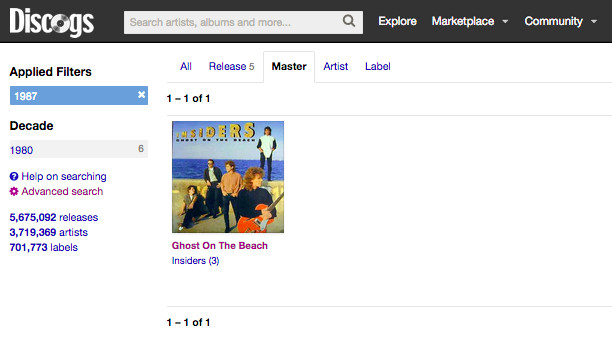 Discogs Insiders Search
Discogs Insiders Search
Alt text: Discogs search results for “35,000” and year 1987, directly leading to the discovery of the Insiders’ song, a deep album cut.
Its obscurity explains why it remained unidentified for years. It wasn’t a single and wasn’t readily available on major streaming platforms initially. Verification required finding it on the now-defunct Grooveshark. It has since been uploaded to YouTube by a band member.
Example #3: No Audio, Just Bingo
Slicing Up Eyeballs again posted a reader’s query on Facebook:
NAME THAT TUNE: Scott’s having trouble tracking down a song he used to have on a mixtape. Does this ring a bell for anyone?
“I have what seems to be the common ‘I had a mix tape years ago, what the hell was that song’ problem. ’93 in college a buddy made me a killer mix tape. I lost the track listing after many moves, but have managed to hunt down almost all of the songs except one. Here’s what I remember:
“The song begins with a clip of a British man calling bingo. He mentions one number and then says ‘blue? 22. We have a bingo- in TWO places.’ Then it cuts into the song. That is all I remember. I can tell you it was ’93 or prior. Any help from the good folks who follow you would be fantastic.”
Audio clues: None. No musical snippet, genre hints, or lyrical clues beyond the bingo intro.
Lyrical clues: Only the spoken bingo intro. Uncertainty about lyrics or instrumental nature of the song itself.
The search: Two concrete facts: bingo intro, pre-1993 release. Assumption: British artist due to the bingo hall audio. “Bingo” became the starting point, despite no guarantee of it being in the title.
Discogs Track Title search for “bingo” yielded 2,848 results. Filtering by UK release narrowed it to 562. Filtering further to 1990s releases reduced it to 143. “Text With Covers” view option enabled quick year identification.
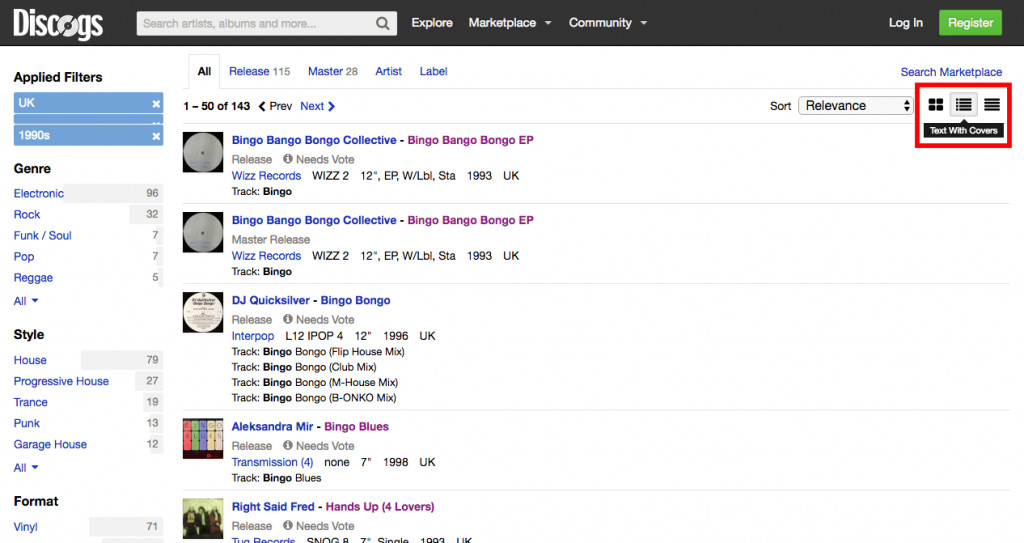 discogs_bingo_search_results
discogs_bingo_search_results
Alt text: Discogs search results for “bingo,” showcasing “Text With Covers” view for efficient year identification while searching for electric guitar rock songs or other genres.
Scanning the first 50 results, excluding post-1993 releases, and checking YouTube videos led to Snuff’s 1992 album Reach.
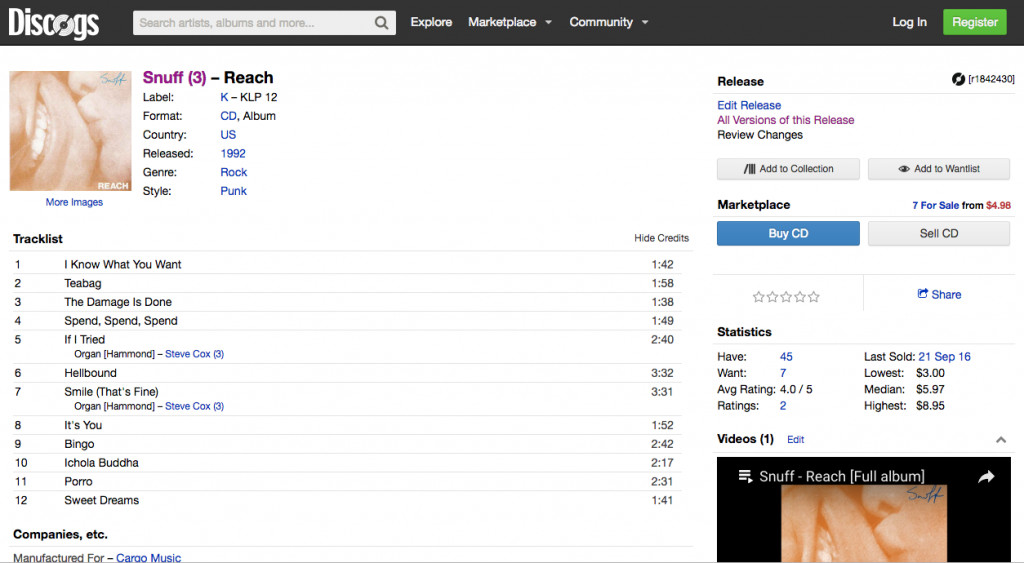 discogs_snuff_reach
discogs_snuff_reach
Alt text: Discogs release page for Snuff’s “Reach” album, revealing “Bingo” track and YouTube video link for verification of the bingo intro.
The album’s YouTube video confirmed the bingo intro at the beginning of track 9, “Bingo,” at 21:32. However, a standalone “Bingo” video on YouTube lacked the spoken intro, and the song differed from the one following the bingo clip in the album video.
Analysis of track times revealed the bingo clip was actually at the end of “Bingo.” The song sought was likely the next track, “Ichola Buddha,” potentially mistaken as starting with the bingo clip on the mixtape.
This method, while reliant on certain conditions and a degree of luck, offers a powerful approach to solving mystery song puzzles, even those electric guitar rock tracks you encounter in unexpected places like meme endings. It’s a valuable tool when collective guesswork falls short.
If this method helps you identify a long-sought song, share your story – the song’s origins, your search journey, and how you finally cracked the case!
(cassette photo by Laurent Hoffmann)

